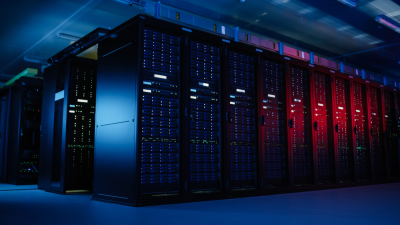Highlights:
- SDI’s transformative approach shifts the focus from physical hardware to centralized control and automation, allowing for dynamic provisioning, policy enforcement, and security advanced analytics.
- Software-defined infrastructure (SDI) brings many advantages to organizations, transforming the management and deployment of IT infrastructure.
Virtualization was introduced many decades ago to revolutionize the consumption of IT infrastructure resources. This technology created a logical separation between physical hardware and software resources, enabling organizations to enhance the performance and delivery of IT services.
In the years that followed, the industry underwent significant transformations, and modern IT infrastructure is now facing unprecedented demands, including:
- Flexibility
- Security
- Service availability
The growing reliance on technology to connect with end-users and customers has compelled vendors to explore novel and efficient methods of meeting high Service Level Agreement (SLA) standards.
One such approach that has gained popularity is software-defined infrastructure (SDI).
Let’s take a closer look.
Why are Organizations Transitioning to SDI?
SDI offers a quick and efficient response to changes, faster and more reliable application and service deployment, and improved IT operational efficiency.
It enables consistent policy-based provisioning, better infrastructure availability, and security management, generating advanced analytics for predictive insights.
SDI allows for a cloud-ready infrastructure that offers scalability, performance, and resilience for high-quality user and customer experiences.
However, managing the transition from hardware-centric to SDI is critical for a successful digital transformation and may add complexity to software asset management and hybrid infrastructures.
How Does Software Defined Infrastructure Work?
By decoupling hardware from software and leveraging virtualization, SDI enables organizations to achieve greater flexibility, scalability, and efficiency.
The transformative approach shifts the focus from the physical hardware to centralized control and automation, allowing for dynamic provisioning, policy enforcement, and security advanced analytics.
The typical components of the software-defined infrastructure stack include:
- Physical infrastructure: In the context of SDI, physical infrastructure refers to the hardware resources, such as servers and networking devices, as well as firmware, hypervisors, and other endpoint terminals.
These infrastructure components can be scaled continuously to meet your evolving IT requirements, while the SDI functionality can extend to cover the expanding infrastructure.
- Virtualization layers: These layers are applied to infrastructure resources, such as storage and network components, using virtualization technology.
They maintain a heterogeneous architecture of computing resources. This component is located directly above the physical infrastructure level in SDI architecture.
- Software-defined capabilities:SDN, Software-Defined Compute, and Software-Defined Storage are applied to the virtualized layer of computing resources.
Intelligent monitoring and control systems automatically transform the resources according to architecture policies.
Your end-users can define resource provisioning and server deployment requirements while the control systems configure the infrastructure and manage the virtualized resources.
- Management services:SDI may use a user interface to define parameters like SLA performance, availability, scalability, and elasticity.
Your IT admins or internal IT users can request resource provisioning. The management services layer handles all infrastructure operations required to maintain the desired SLA and performance standards.
Software-defined infrastructure (SDI) brings many advantages to your organization by transforming the management and deployment of IT infrastructure. In this section, we will delve into the benefits that SDI provides.
Advantages of SDI
SDI provides your business with increased flexibility, scalability, and efficiency by separating hardware from software. Your organization can dynamically allocate resources, automate operations, and quickly respond to changing business requirements with SDI.
The benefits of SDI are as follows:
- Enhanced control: Organizations can achieve greater efficiency by adopting cloud-based management of software-defined technologies.
Activating SDI controllers unlocks numerous capabilities, such as centralized access management, improved quality of service, risk mitigation, and secure device and policy deployment.
- Increased automation: Leverage automation and machine learning in service platforms to mitigate risk and improve responsiveness.
- Advanced monitoring and analytics: SDI minimizes the requirement for extensive physical infrastructure maintenance by utilizing centralized intelligence to drive performance, enforce policies, and enable advanced analytics for business continuity and threat prevention.
Management platforms provide data-driven insights, simplifying the management of hardware and software assets.
- Standardization: SDI ensures standardization across your infrastructure, centrally enforcing policies and eliminating inconsistencies. Upgrading software versions becomes streamlined, avoiding the need for manual installations on individual machines.
- Scalability: SDI enables easy scalability and agility compared to traditional hardware. Remote provisioning and configuration of technologies allow adaptation to dynamic business demands.
- Speed: Automation streamlines operational processes, enhancing efficiency in initial deployment, provisioning, and software version compliance.
- Simplification: APIs facilitate the management of multiple technologies, leveraging advanced analytics.
- Cost-effectiveness: Consolidating subscription software investments into Enterprise Agreements often yields savings of over 30%. License management insights mitigate financial risk, ensure efficient usage, and provide visibility of license entitlements.
- Enhanced security: SDI’s data utilization, centralized control, and platform automation reduce the risk of human error. Advanced analytics, predictive insights, and security notifications facilitate proactive intervention.
Conclusion
Software-defined infrastructure (SDI) is a cutting-edge solution that empowers businesses to achieve greater flexibility, scalability, and efficiency by decoupling hardware from software.
With SDI, organizations can enjoy consistent policy-based provisioning, improved infrastructure availability and security management, and advanced analytics that provide predictive insights.
The benefits of SDI include enhanced control, increased automation, advanced monitoring and analytics, standardization, scalability, speed, simplification, cost-effectiveness, and improved security.
However, it’s essential to properly manage the transition from hardware-centric to SDI to ensure a successful digital transformation, while hybrid infrastructures may add complexity to the process.
Unlock valuable insights with our extensive collection of IT Infra-focused whitepapers.










